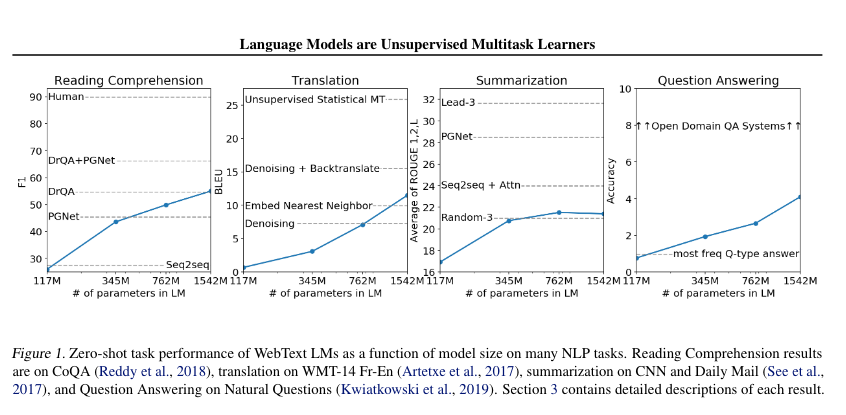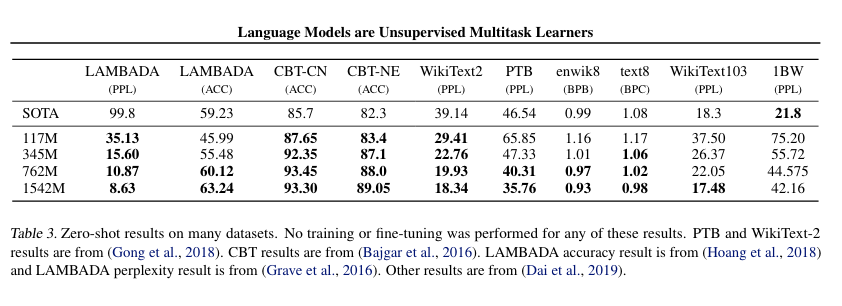FYI: Annotated Bibliography Item: Language Models are Unsupervised Multitask Learners
Wu J, Child R, Luan D, Amodei D, Suskeve I (2018) Language Models are Unsupervised Multitask Learners. URL: https://d4mucfpksywv.cloudfront.net/better-language-models/language_models_are_unsupervised_multitask_learners.pdf
Good summary of the above here: https://towardsdatascience.com/one-language-model-to-rule-them-all-26f802c90660


“Abstract. Natural language processing tasks, such as question answering, machine translation, reading comprehension, and summarization, are typically approached with supervised learning on task-specific datasets. We demonstrate that language models begin to learn these tasks without any explicit supervision when trained on a new dataset of millions of webpages called WebText… These findings suggest a promising path towards building language processing systems which learn to perform tasks from their naturally occurring demonstrations.” (p. 1);
“1. Introduction. Current systems are better characterized as narrow experts rather than competent generalists. We would like to move towards more general systems which can perform many tasks – eventually without the need to manually create and label a training dataset for each one. The dominant approach to creating ML systems is to collect a dataset of training examples demonstrating correct behavior for a desired task, train a system to imitate these behaviors, and then test its performance on independent and identically distributed (IID) held-out examples… Multitask learning (Caruana, 1997) is a promising framework for improving general performance. However, multitask training in NLP is still nascent… his suggests that multitask training many need just as many effective training pairs to realize its promise with current approaches. It will be very difficult to continue to scale the creation of datasets and the design of objectives to the degree that may be required to brute force our way there with current techniques. This motivates exploring additional setups for performing multitask learning.” (p. 1);
“2. Approach. Learning to perform a single task can be expressed in a probabilistic framework as estimating a conditional distribution p(output|input). Since a general system should be able to perform many different tasks, even for the same input, it should condition not only on the input but also on the task to be performed. That is, it should model p(output|input, task). This has been variously formalized in multitask and meta-learning settings. Task conditioning is often implemented at an architectural level, such as the task specific encoders and decoders in (Kaiser et al., 2017) or at an algorithmic level such as the inner and outer loop optimization framework of MAML (Finn et al., 2017). But as exemplified in McCann et al. (2018), language provides a flexible way to specify tasks, inputs, and outputs all as a sequence of symbols. For example, a translation training example can be written as the sequence (translate to french, english text, french text). Like-wise, a reading comprehension training example can be written as (answer the question, document, question, answer). ” (p. 2).
“Language modeling is also able to, in principle, learn the tasks of McCann et al. (2018) without the need for explicit supervision of which symbols are the outputs to be predicted. Since the supervised objective is the the same as the unsupervised objective but only evaluated on a subset of the sequence, the global minimum of the unsupervised objective is also the global minimum of the supervised objective. In this slightly toy setting, the concerns with density estimation as a principled training objective discussed in (Sutskever et al., 2015) are side stepped. The problem instead becomes whether we are able to, in practice, optimize the unsuper- vised objective to convergence. Preliminary experiments confirmed that sufficiently large language models are able to perform multitask learning in this toy-ish setup but learning is much slower than in explicitly supervised approaches.” (p. 2).
“While it is a large step from the well-posed setup described above to the messiness of “language in the wild”, Weston (2016) argues, in the context of dialog, for the need to develop systems capable of learning from natural language directly and demonstrated a proof of concept – learning a QA task without a reward signal by using forward prediction of a teacher’s outputs. While dialog is an attractive approach, we worry it is overly restrictive. The internet contains a vast amount of information that is passively available without the need for interactive communication. Our speculation is that a language model with sufficient capacity will begin to learn to infer and perform the tasks demonstrated in natural language sequences in order to better predict them, regardless of their method of procurement. If a language model is able to do this it will be, in effect, performing unsupervised multitask learning. We test whether this is the case by analyzing the performance of language models in a zero-shot setting on a wide variety of tasks.” (p. 2);
“2.1. Training Dataset. Most prior work trained language models on a single domain of text, such as news articles (Jozefowicz et al., 2016), Wikipedia (Merity et al., 2016), or fiction books (Kiros et al., 2015). Our approach motivates building as large and diverse a dataset as possible in order to collect natural language demonstrations of tasks in as varied of domains and contexts as possible.” (p. 3);
“Instead, we created a new web scrape which emphasizes document quality. To do this we only scraped web pages which have been curated/filtered by humans. Manually filtering a full web scrape would be exceptionally expensive so as a starting point, we scraped all outbound links from Reddit, a social media platform, which received at least 3 karma. This can be thought of as a heuristic indicator for whether other users found the link interesting, educational, or just funny.” (p. 3);
“The resulting dataset, WebText, contains the text subset of these 45 million links. To extract the text from HTML responses we use a combination of the Dragnet (Peters & Lecocq, 2013) and Newspaper1 content extractors. All results presented in this paper use a preliminary version of WebText which does not include links created after Dec 2017 and which after de-duplication and some heuristic based cleaning contains slightly over 8 million documents for a total of 40 GB of text. We removed all Wikipedia documents from WebText since it is a common data source for other datasets and could complicate analysis due to over-lapping training data with test evaluation tasks.” (p. 3-4);
“2.2 Input Representation. A general language model (LM) should be able to compute the probability of (and also generate) any string. Current large scale LMs include pre-processing steps such as lower-casing, tokenization, and out-of-vocabulary tokens which restrict the space of model-able strings… Byte Pair Encoding (BPE) (Sennrich et al., 2015) is a practical middle ground between character and word level language modeling which effectively interpolates between word level inputs for frequent symbol sequences and character level inputs for infrequent symbol sequences. Despite its name, reference BPE implementations often operate on Unicode code points and not byte sequences… To avoid this, we prevent BPE from merging across character categories for any byte sequence. We add an exception for spaces which significantly improves the compression efficiency while adding only minimal fragmentation of words across multiple vocab tokens. This input representation allows us to combine the empirical benefits of word-level LMs with the generality of byte-level approaches. Since our approach can assign a probability to any Unicode string, this allows us to evaluate our LMs on any dataset regardless of pre-processing, tokenization, or vocab size.” (p. 4)’
“2.3. Model. We use a Transformer (Vaswani et al., 2017) based architecture for our LMs. The model largely follows the details of the OpenAI GPT model (Radford et al., 2018) with a few modifications.” (p. 4);
“3. Experiments. We trained and benchmarked four LMs with approximately log-uniformly spaced sizes. The architectures are summarized in Table 2. The smallest model is equivalent to the original GPT, and the second smallest equivalent to the largest model from BERT (Devlin et al., 2018).” (p. 4);
“3.1. Language Modeling. As an initial step towards zero-shot task transfer, we are interested in understanding how WebText LM’s perform at zero-shot domain transfer on the primary task they are trained for – language modeling. Since our model operates on a byte level and does not require lossy pre-processing or tokenization, we can evaluate it on any language model benchmark.” (p. 4);
“For many of these datasets, WebText LMs would be tested significantly out-of-distribution, having to predict aggressively standardized text, tokenization artifacts such as disconnected punctuation and contractions, shuffled sentences, and even the string which is extremely rare in WebText – occurring only 26 times in 40 billion bytes. We report our main results in Table 3 using invertible de-tokenizers which remove as many of these tokenization / pre-processing artifacts as possible.” (p. 4-5);
“[3.2 – 3.8 Tasks.] 3.2. Children’s Book Test. The Children’s Book Test (CBT) (Hill et al., 2015) was created to examine the performance of LMs on different categories of words: named entities, nouns, verbs, and prepositions… 3.3. LAMBADA. The LAMBADA dataset (Paperno et al., 2016) tests the ability of systems to model long-range dependencies in text… 3.4. Winograd Schema Challenge. The Winograd Schema challenge (Levesque et al., 2012) was constructed to measure the capability of a system to perform commonsense reasoning by measuring its ability to resolve ambiguities in text… 3.5. Reading Comprehension. The Conversation Question Answering dataset (CoQA) Reddy et al. (2018) consists of documents from 7 different domains paired with natural language dialogues between a question asker and a question answerer about the document… 3.6. Summarization. We test GPT-2’s ability to perform summarization on the CNN and Daily Mail dataset (Nallapati et al., 2016). To induce summarization behavior we add the text TL;DR: after the article and generate 100 tokens with Top-k random sampling (Fan et al., 2018) with k= 2 which reduces repetition and encourages more abstractive summaries than greedy decoding. 3.7. Translation. We test whether GPT-2 has begun to learn how to translate from one language to another. In order to help it infer that this is the desired task, we condition the language model on a context of example pairs of the format english sentence = french sentence and then after a final prompt of english sentence = we sample from the model with greedy decoding and use the first generated sentence as the translation. 3.8. Question Answering. A potential way to test what information is contained within a language model is to evaluate how often it generates the
correct answer to factoid-style questions.” (p. 5-7).
“4. Generalization vs Memorization. Recent work in computer vision has shown that common image datasets contain a non-trivial amount of near-duplicate images.” (p. 8).
“5. Related Work. A significant portion of this work measured the performance of larger language models trained on larger datasets.” (p. 8).
“6. Discussion. Much research has been dedicated to learning (Hill et al.,2016), understanding (Levy & Goldberg, 2014), and critically evaluating (Wieting & Kiela, 2019) the representations of both supervised and unsupervised pre-training methods. Our results suggest that unsupervised task learning is an additional promising area of research to explore.” (p. 9);
“7. Conclusion. When a large language model is trained on a sufficiently large and diverse dataset it is able to perform well across many domains and datasets. GPT-2 zero-shots to state of the art performance on 7 out of 8 tested language modeling datasets. The diversity of tasks the model is able to perform in a zero-shot setting suggests that high-capacity models trained to maximize the likelihood of a sufficiently varied text corpus begin to learn how to perform a surprising amount of tasks without the need for explicit supervision.” (p. 10);
References include one of my favorites from IBM Research (circa 1980, based on a lot of work in the 1970’s) – Jelinek, F. and Mercer, R. L. Interpolated estimation of markov source parameters from sparse data. In Proceedings of the Workshop on Pattern Recognition in Practice, Amsterdam, The Netherlands: North-Holland, May. , 1980
Pingback: Bất ngờ: AI năm 2019 – Việt Nam
Pingback: Kejutan: AI Pada 2019 – Indonesia